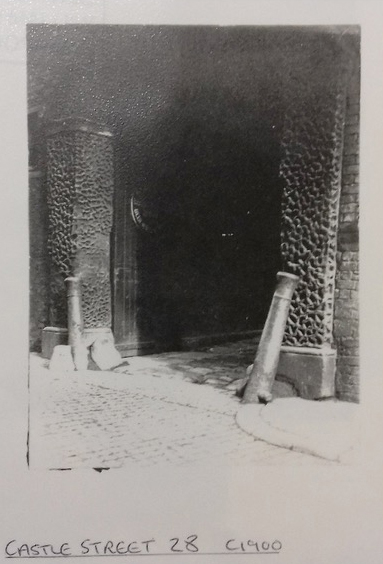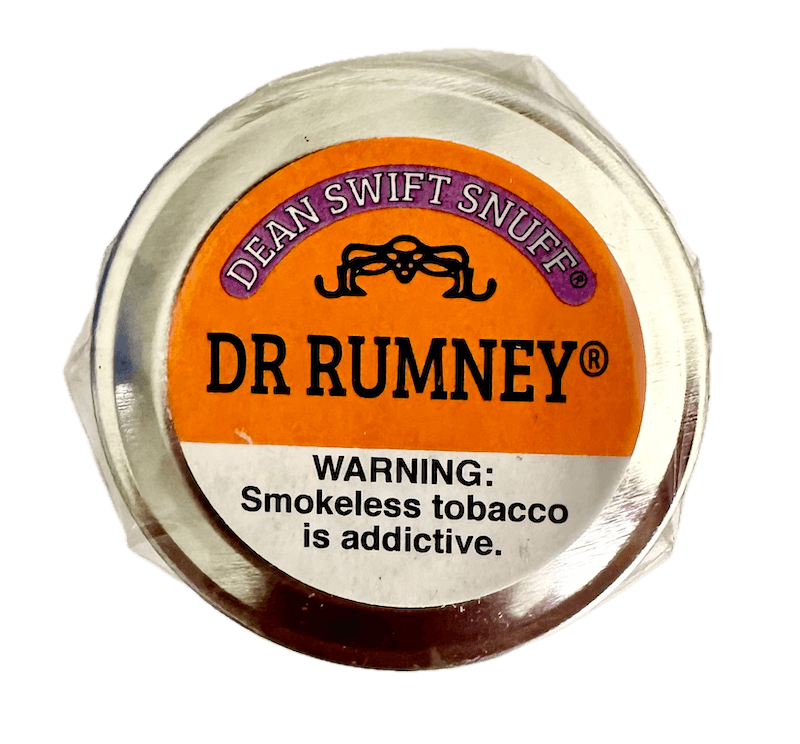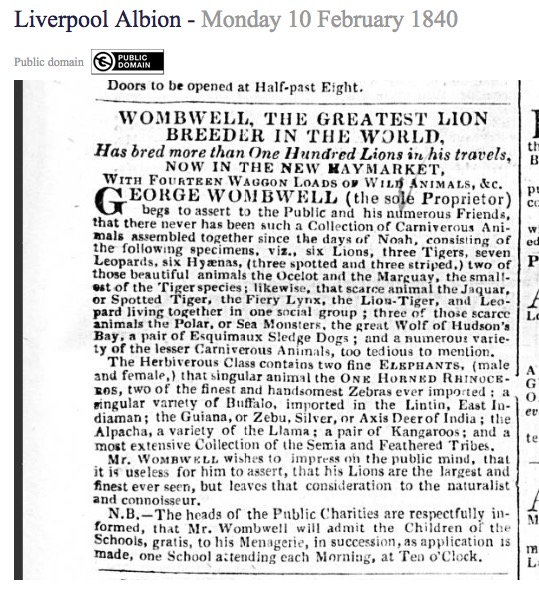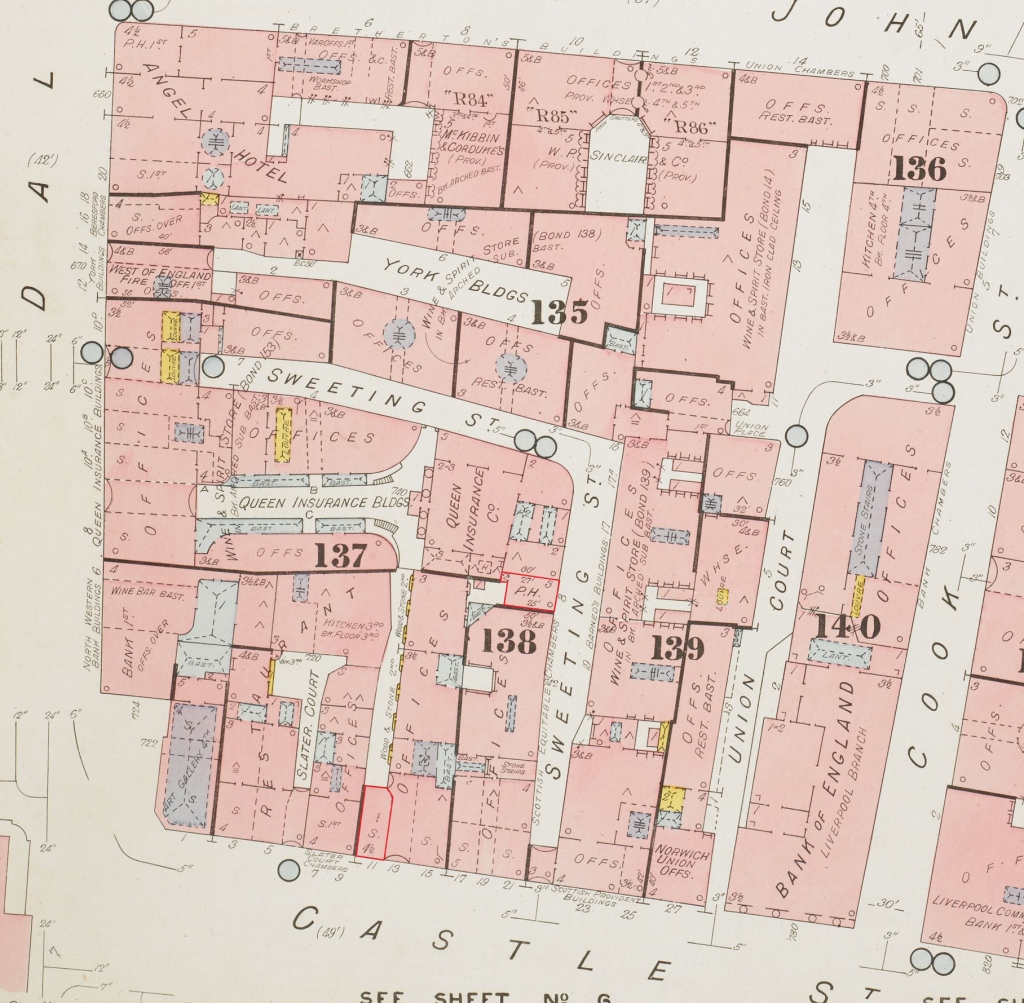As a change to my usual posts, this one relates to central Liverpool. It was originally intended to have been published some years ago on the Bygone Liverpool.
This watercolour from the archives of Liverpool Libraries is by Hugh Magenis (1844 – 1906) and dates from circa 1887.

The entrance to Dean Swift’s Box was actually on Swift’s Court, the watercolour actually shows the rear of the premises on Sweeting Street. The court ran from Castle Street and was parallel to Sweeting Street. The name Swift’s Court doesn’t exist anymore, as it later became Queen Avenue.
The entrance to Swift’s Court on Castle Street may have been this one below that was photographed ‘circa 1900’ but might be earlier (note the cannons used as bollards). This may have been replaced by the present double entrance to Queen Avenue.
How the pub got its name
Swift’s Court was named after a family of coopers (barrel makers) named Swift. This family came from humble beginnings, shown as coopers lodging in premises from 1705. By 1753 Jonathon Swift was on Castle Street. This was likely to have been 11 Castle Street that led to Swift’s Court. Rachel Swift was born in 1764 and was the daughter of Joshua Swift. As early as 1777 her name appears in the directory as a cooper and fruitier of Castle Street. She was shown leasing a property there in 1781, but she was shown as a cooper and fruitier in 1777.
The pub began as the Eagle Tavern and appears as such on the 1847 ordnance survey map. The Eagle Tavern was up ‘for sale or let’ in 1848 and was shown to have been in the possession of a tobacconist named John Turmeau. Turmeau’s premises were 11 Castle Street and backed onto the public house.

John Turmeau was a miniature portrait painter. In 1822 he opened a snuff shop at 17 Houghton Street but continued to paint.
Turmeaus are still trading and still selling cigars in Liverpool (and other places as they are now owned by C.Gars). Their current address is the Albany Building, 8 Old Hall Street. They have been trading for over 200 years and may rank as Liverpool’s oldest company that’s still in business.
But who was ‘Dean’ Swift, and what did the box refer to?
In 1847 it was widely reported that the snuff box belonging to Jonathon Swift was to be sold. Swift (1667 – 1745) was most famous as being the author of Gulliver’s Travels (published 1726). He was an Anglican Cleric who became Dean of St. Patrick’s cathedral, Dublin. Because of this he was known as Dean Swift.
The snuff box had been mentioned in Swift’s will. It contained a note entitled “A Pinch of Snuff from Dean Swift’s Box“. It’s easy to imagine how this story caught the attention of Liverpool tobacconist Turmeau who owned a pub on Swift’s Court.
“A Pinch of Snuff from Dean Swift’s Box.”
Notes and Queries, Vol. V, Number 125, March 20, 1852
—Some years ago I saw in the shop of a dealer in curiosities, in London, an old snuff-box, which was said to have belonged to Dean Swift; it was accompanied with three printed leaves, of the common octavo size, the first page of which commenced with “A Pinch of Snuff from Dean Swift’s Snuff Box,” (being a description of the snuff-box in question). The next subject on the leaves began with “‘Tis a hundred years since.” The leaves appeared to have been extracted from some Irish magazine or periodical, published about the year 1845-6, and to contain much valuable and amusing matter. As I have made repeated inquiries among the London booksellers in vain, for the name of the publication from which the above-mentioned extract was taken, I shall feel much obliged if you will permit me to make a similar inquiry through the medium of “N. & Q.,” and by so doing you will confer a great favour upon.
A SUBSCRIBER.
Dean Swift became a popular name for pubs and one company named a brand of snuff after him, which is apt because ‘Swift was such an addict of snuff that even his prayer book was sullied as a result‘
It appears that snuff named after Dean Swift is still available to buy.
Turmeau never sold the Eagle Tavern in 1848 but let it out instead. This advertisement from 1883 show’s that 11 Castle Street and Dean Swift’s Box in Swift’s Court was still owned by John and Charles Turmeau but leased out to tenants. Soon after this, the Eagle Tavern was renamed Dean Swift’s Box.

Was a bear kept in Dean Swift’s Box?
WARNING! This next section contains stories of animal cruelty. But please stick to the end because we’ll discover they were likely just invented as part of bizarre advertising campaigns by unscrupulous hairdressers.
In 1864 a very strange and macabre advertisement for Dean Swift’s Box appeared in the Liverpool Daily Post. Rather than extolling its virtues as a drinking establishment, it was merely a poem about a volunteer in the Rifle Corps nicknamed ‘Pickles’ had shot a bear on the premises:-
WHO, HOW, AND WHERE THE BEAR WAS SHOT
Pickles, oh! Pickles, why, what have you done?
You sly, you cunning, but cruel little fox :
‘Twas Barber-rous, shooting a ear for your fun !
In the hallow’d precincts of “DEAN SWIFT’S LITTLE BOX.
Toll the bell, the Bear is dead ;
Sound the tocsin loud as thunder ;
Low lies Bruin’s mangled head,
And gaping rustics gaze and wonder.
And who the cruel deed hath done?
Not fierce array of scythes and sickles,
But bullets from the erring gun
Of pseudo volunteer called Pickles.DEAN SWIFT’S BOX
Liverpool Daily Post – Saturday 06 February 1864
SWIFT’S COURT, CASTLE-STREET
Bears (supposedly) killed in Liverpool for a cure for baldness
Note that the poem in the advertisement makes the pun Barber-rous. This relates to a hairdresser and perfumer named James Wynes who’s barber shop was above Turmeau’s cigar shop, and therefore right next to Dean Swift’s Box.
Wynne was in a partnership with John Gorsuch (who also ran a school). In 1854, Gorsuch was advertising ‘Genuine Bear Grease for the restoration of hair’ at 7 Parker Street but was also trading with Wynes at Swift’s Court until the partnership was dissolved in 1859.
Bear’s Grease was a Quack cure for baldness. It was used from the 17th century right up to the First World War. It was made from the fat of Brown Bears, with beef marrow added and perfume to disguise the disgusting smell.
The demand for the product far exceeded the supply of slaughtered bears, so most ‘Bear’s Grease’ was actually just perfumed lard. ‘Genuine Bear’s Grease’ was therefore in high demand by our follically-challenged ancestors.
Hairdressers and perfumers like Gorsuch and Wynes would go to great lengths to reassure their Bear-headed punters that their product was the genuine article. To this end a bear skin would often be kept on the premises.
Liverpool Newspaper advertisements actually state how many bears had been slaughtered. M. Kelly of 63 Bold Street boasted of a fine young bear being slaughtered on their premises in 1840. Another, that could be viewed alive in the shop, was to be killed at 12 O’Clock on the 8th December and its body was displayed in the window.

Gorsuch boasted that he had personally killed 25 bears in 1847. By 1860 Gorsuch was proudly advertising that they had slaughtered 54 bears!

Bear escaped from its den in Aigburth
The story of Pickles shooting the bear in Dean Swift’s Box likely originated from an advertisement that appeared in 1854. Gorsuch claimed that a bear had escaped from his premises after breaking loose from his den and was shot by a gentleman in pursuit of him. Just 5 days later Gorsuch was flogging the grease.
On 6th Febrauary 1854 the Liverpool Albion reported that a bear had been kept at Holmfield, Aigburth and its escape had caused much distress to the residents of the area. He was pursued but all attempts to capture him was fruitless. He was shot and ‘was in the process of being converted into ‘Genuine Bear’s Grease’.

The end of that news story sounds suspiciously like an advertisement – I’ll come to that later.
The trouble with this story is that it had nothing to do with Swift’s Court. It’s possible this was a trifling detail that was overlooked by the time the poem appeared ten years later. But we will discover that this detail may have little consequence but it may never have happened at all. Unscrupulous shopkeepers would fool their customers by having a fake bear carcass in their shop:-
Some years ago, it was the custom for perfumers and hairdressers to keep bears on their premises, and to poke them up when there was any indication of a crowd, in order to show that they had the real thing. Every now and then, the carcass of a bear was seen hung up at their shop-doors, and the attention of the spectators drawn to it by enormous placards, gorgeous in all the colours of the rainbow.
But the reader must not be deceived, as were the passers-by, and imagine that the suspended animal was really a bear. No; the hairdresser knows the value of bears to well for that. He therefore keeps a bear-skin on the premises, buys a nice large fat hog, puts it into the bear-skin, advertises- ”Another fine bear to be slaughtered at Jones’s to-morrow,” and next day hangs up the pig by his hind legs. Many-persons used to purchase permission to rub their heads in the body of the bear, in order to insure getting real bear’s grease. Permission was always liberally accorded, at the rate of one shilling per head, and both parties were equally satisfied.
Animal Traits and Characteristics, Or, Sketches and Anecdotes of Animal Life. John George Wood, 1855
Back in 1844 it was known that advertisements that claimed a bear was to be slaughtered were merely ploys to dupe customers:-

It appears then that a generous pinch of salt must be taken with these stories. It’s highly possible that no, or very few bears were ever killed by hairdressers in Liverpool. I have been unable to find any newspaper article relating to an escaped bear in Liverpool, other than the advertisement. This statement from 1845 mentioning seeing a slaughtered bear in Gorsuch’s premises, but knowing the grizzly deceptions hairdressers resorted to, this may have been ‘a pig in bear’s clothing’:-
“Bears’ Grease. —We have had ocular demonstration that Mr. Gorsuch sells the above article genuine, having seen a slaughtered Bear on his premises, on Wednesday last.
Liverpool Mail, Saturday 25 October 1845
But Gorsuch took his bogus advertising campaign to another level in 1860, when he advertised the shooting of the largest bear in England…
The largest Russian Bear in England to to shot on Crosby Sans for rifle practice (at 5 shillings a pop)
On the 9th January 1860 Gorsuch announced that the largest Russian that has yet been seen in England would be slaughtered for it’s grease. This advertisement below was published the following day. Gorsuch announced he planned to charge ‘Gentlemen’ 5 shillings each to test their rifle skills on the bear on Crosby Sands:-
BEAR SHOOTING.
Northern Daily Times – Tuesday 10 January 1860
Mr. BARRETT, of “The London” has been empowered by Mr. Gorsuch, of Parker-street, to open a List. The entry of the names of Gentlemen who wish to test their Rifle practice upon the RUSSIAN BEAR just imported, on SATURDAY NEXT, the 14th inst., at low tide, on CROSBY SANDS. Terms 5s. each entry. All entering to draw lots for the skin. The conditions of shooting to be known at “The London”, Clayton Square.
Benjamin Colley wrote a letter the next day and stated that the Society for Prevention of Cruelty to Animals should look into it.
BEAR-BATING.
Liverpool Daily Post, Wednesday 11 January 1860
TO THE EDITOR OF THE DAILY POST.
Sir, —In your columns of yesterday I notice advertisement to the effect that Mr. Gorsuch, hairdresser, of this town, who has lately imported a Russian bear, intends affording amusement to our noble volunteers, and also profit to himself, by exposing the poor animal, as a target for a number unskilled marksmen. Surely this should looked at by the Society for Prevention of Cruelty to Animals.—Yours, &c., BENJ. COLLEY
Gorsuch was undeterred, in fact he boasted that he’d shot 53 bears so far. Gorsuch wrote ‘I see nothing to call forth the interference of Prevention of Cruelty to Animals, or the maudlin sentimentality of your correspondent’.
BEAR SHOOTING. TO THE EDITOR OP THE DAILY POST
Allow me to divest your correspondent, Mr. B. Colley, and the public generally, of the idea that any undue cruelty will practised on the bear announced to be shot on Crosby Sands, next week. During the years I have been in have been in business, I have had no less than fifty-three bears shot, for the purpose of furnishing the toilet table with an article esteemed by those who have used it — pure bear’s grease.
The mode adopted in despatching these animals has been to chain them securely and with the aid of a rifle, aimed at the forehead (one shot usually sufficing) — stop their earthly career. It is upon exactly similar conditions that the bear will be shot on Crosby Sands, set forth in the advertisement in the Daily Post, except that the favour of shooting him will belong to the individual winning the chance of having the first shot at him.
Mr. Colley pays but a poor compliment the efficiency our Rifle Corps ; he must not suppose he will submit the bear to be riddled by the whole corps. It must be an unskilful marksman indeed who cannot, at sixty yards distance, hit with rifle an object covering a space of a square foot. The bear must be killed, and I see nothing to call forth the interference of Prevention of Cruelty to Animals, or the maudlin sentimentality of your correspondent, Yours, 7, Parker-street. JOHN GORSUCH.
Liverpool Daily Post Thursday 12 January 1860
A further reply accused Gorsuch of murder:-
EDITOR OP THE DAILY POST.
Srs, —In Mr. Gorsuch’s letter in the Post to-day, he says three score of bruins closed their mortal career on earth by being shot. I know how incapable I am of splitting hairs with Mr. Gorsuch ; but as I infer from his statement that that bears are immortal, beg to say that it is murder to kill them at all—
Yours, &c., HIRSUTE
LIverpool Daily Post, 13th January 1860
Don’t worry! The bear wasn’t shot, inn fact it had three cubs
You will be relieved to discover that the bear was not shot. In fact it gave birth to three cubs just one day before the planned execution:-
EXTRAORDINARY BIRTH.
The BEAR, announced to Shot on the 17th, on Crosby Sands, gave birth to THREE CUBS, yesterday. A RESPITE has been granted, which for the present, prevents the sentence of death from being carried out.
J. Gorsuch will duly appraise the Public when Mr Barrett’s list will be reopened.
Northern Daily Times – Tuesday 17 January 1860
I have been unable to discover more of the fate of the bear. It’s likely that Gorsuch never intended to have the bear shot. It probably wasn’t even his bear. Wild and exotic animals were commonplace in cities in England, especially in large ports such as Liverpool. Gorsuch likely borrowed bears for short periods to con his customers into believing his ‘Genuine Bear’s Grease’. It’s highly likely that his customers were merely slapping perfumed lard onto their slap heads.
James Wynes was bankrupt in 1862. He was listed as Hairdresser, Perfumer and Beerseller.
Gorsuch died in 1892. His obituary didn’t mention the bear-faced cheek he exhibited in conning customers.
THE LATE MR. JOHN GORSUCH
We regret to announce the death of Mr. John Gorsuch, of the Litherland-park, who died at his residence on Sunday morning, in the 72nd year of his age. For over half a century Mr. Gorsuch carried on the business as a hairdresser in Parker-street, Liverpool. In the exercise of his profession he was well known among the leading local families, and both before of and after his retirement from business he was ever ready to assist the poor and needy. In a quiet and unostentatinus way he spent a small fortune in benefiting his poorer brethren, and his name was respected and his death will be regretted by very many of his fellow Citizens.
Liverpool Mercury Wednesday 24 February 1892
Summary
It is possible that a Bear was kept on the premises of Dean Swift’s Box to promote Bear’s Grease, but it was probably only for very short periods.
Liverpool had no shortage of menageries in the 19th century, and it would have been easy to arrange the loan of a bear to coincide with an advertisement. Bears were by no means the most exotic creature that could be viewed on the streets of Liverpool. In New Haymarket in 1840, the famous Wombwell exhibited Lions, Tigers, Eelephants and a Polar Bear and many other animals.
In 1841 you could see two Giraffes in Bold Street…
However, it’s highly unlikely that any Bears were killed for Bear’s Grease because the vast majority of Bear’s Grease was actually only lard. The heads of balding Victorian men must had emitted a whiff akin to chip fat.
The site today
The last mention of the public house was when it was up for sale in 1883. Soon after the buildings on Swift’s Court were demolished and became Queen Avenue.
The pub was either demolished or remodeled when the Royal Bank building was extended into Sweeting Street. This is a section of a plan made in 1888 for fire insurance purposes. I’ve outlined 11 Castle Street and the pub in red.
The building to the right of the pub still survives, as can be seen on this old Yo! Liverpool post. Somewhere under the later building may be surviving parts of the structure of Dean Swift’s Box.

Copyright notice:
Copyright of original archive images belongs to those named below the images. All original research, photographs taken by myself, illustrations, artists impressions, and archive images and maps that have notes added are all ©Jim Kenny. Permission to share is only granted if the site is credited and a link provided.
If you enjoyed this post and would like to show your appreciation, you can Buy me a coffee. This will give me £5 to help me fund my research and continue this website. If you can afford it, you can buy me as many as you like. I’ve got plenty more posts to come. Some of these contain some very important discoveries.
Just click on the logo below.








I wonder if the snuff sold by Turmeau was produced by the water-powered snuff mill that used to be in what is now Otterspool Park?
I think the Otterspool Mill was used for making oil by crushing seeds by then, I’ll double check though. Thanks!